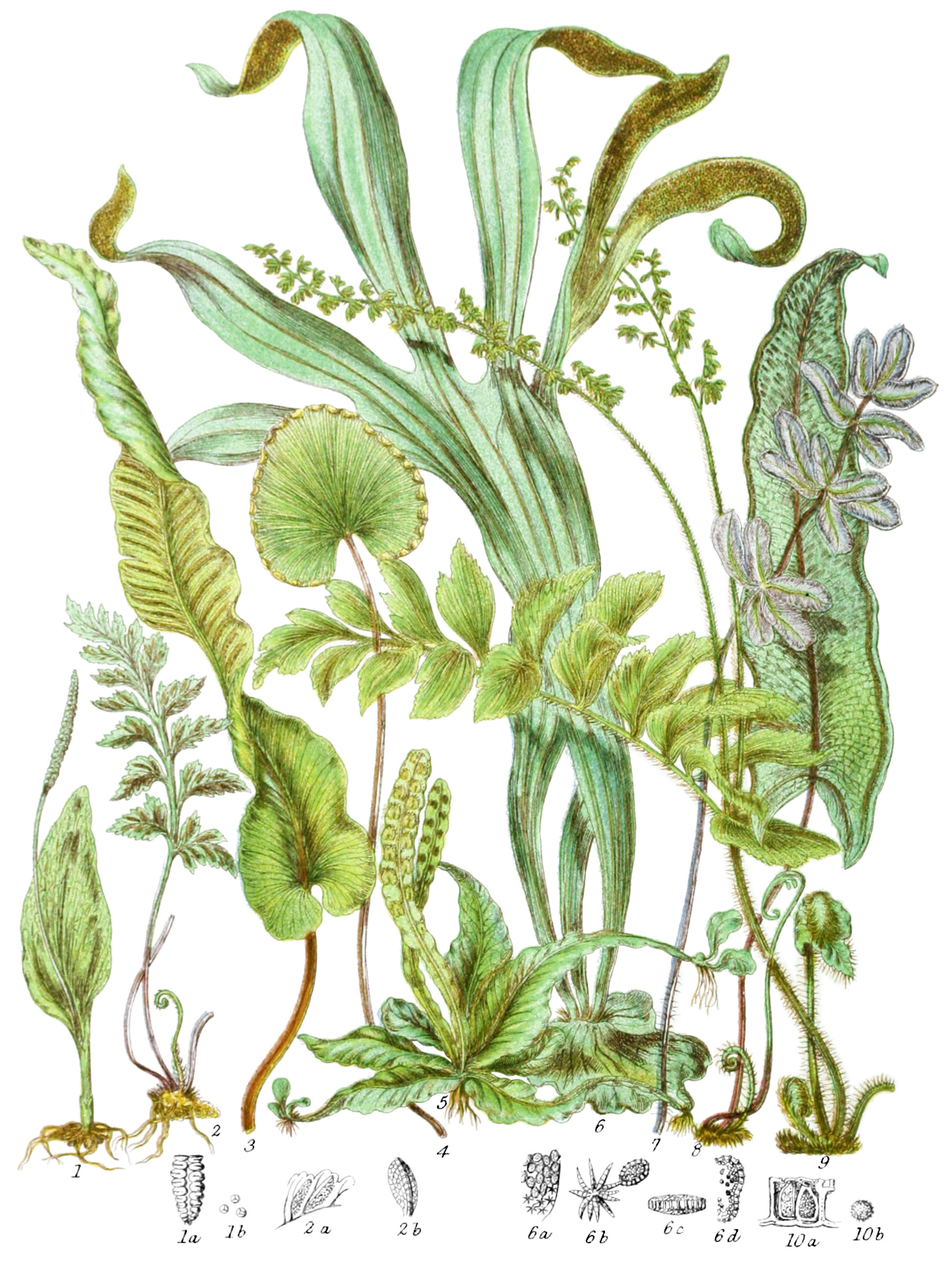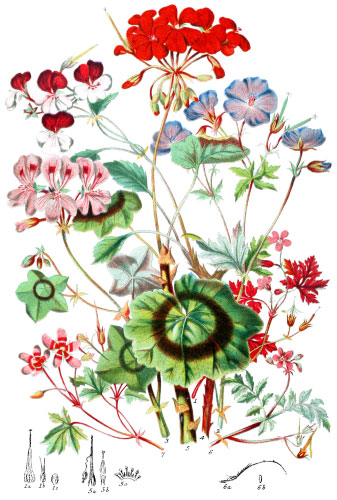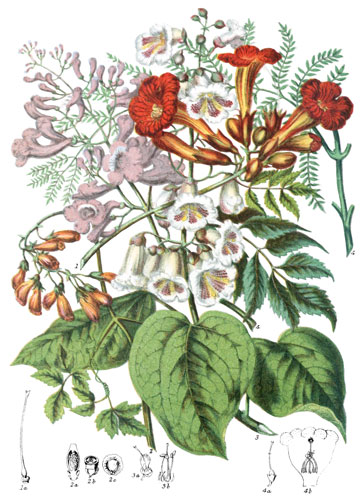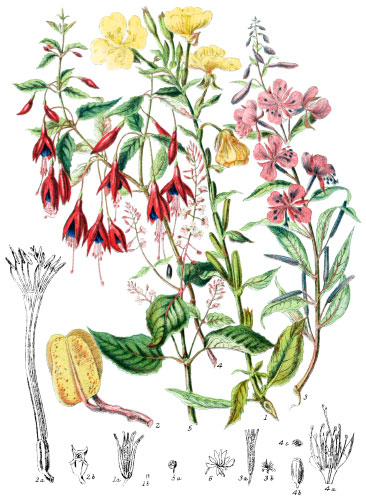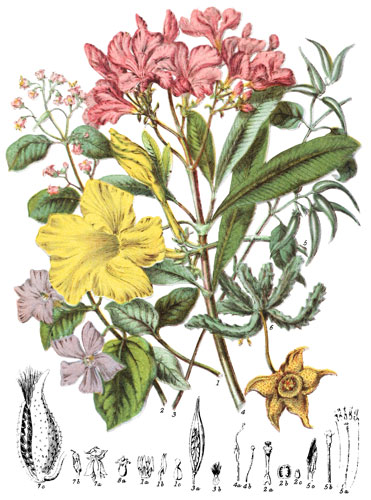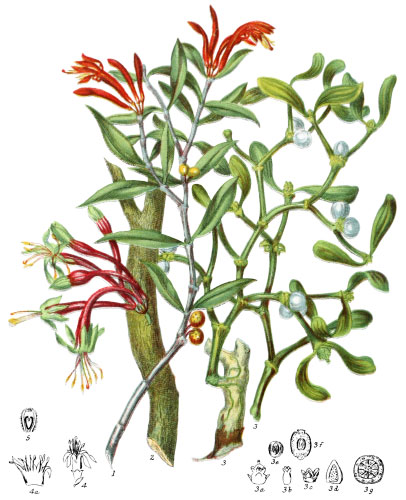Key characteristics
Trees with a tall stem, and of plants with creeping stems, on or below the surface of the ground. The stem grows at the point only, and contains a loose cellular substance, coated by a fibrous rind, composed of the bases of former leaf-stalks. The wood is full of dotted ducts and tubes. The fronds or leaves are coiled up when young, simple or pinnate. The reproductive organs consist of small spores in cases, arising from the veins on the under surface of the leaves, or on their margin; either on a stalk which encircles it like a ring, or destitute of stalk and ring (10a), springing from the surface of the leaf, or from beneath the outer membrane, which then forms a covering to the spore-cases; sometimes in the margin of contracted leaves. The spores fill the cases irregularly, and are scattered when ripe, by the bursting of the elastic ring.
This Tribe has affinity with Cycadaceæ.
Astringent mucilaginous properties exist in the fronds. The pith of some tree-ferns makes Sago; the roots or underground stem of some are eatable.
In this remarkable Tribe, all trace of a flower, with its varied and beautiful development of corolla, disappears; leaves are reduced to the most simple structure, and minute seeds are produced on them, without passing through any previous process of change, as in flowering plants. Although the larger number of Ferns are herbaceous, and of small size, yet some are trees with upright stems thirty feet high, rivalling Palms in general aspect, but retaining all the peculiar characteristics of their Order. The stem is marked with large scars, the remains of leaf-stalks. In the centre of the crown the young fronds are seen coiled round, as the stalk elongates assuming the form of a crosier.
Select plants in this order
Not all plants listed are illustrated and not all plants illustrated are listed.
- Alsophila, Cyathea, and others, are tree-ferns of the isles of the Pacific, and of New Zealand.
- Roots frequently spring from the stem and enlarge its base. No leaf-buds are developed at the base of the leaf-stalks, consequently no ferns are branched; the forked stem of some arborescent species is caused by the accidental growth of two leaf-buds at the summit. The stem is composed of a mass of tissue in the centre, surrounded by fibrous vessels of a dark colour, easily perceived, even in the stem of our common Brake.
- Alsophila gigantea is widely distributed on mountains in India, but not ascending above 4000 feet.
- A. aspera is a native of Jamaica, with a stem of twenty-five feet.
- Ophioglossum belongs to that division of Ferns in which the spore-cases have no ring, but are simply two-valved on the margin of the contracted leaf. The stalk is hollow, with a few bundles of woody fibres in the circumference, indicating a similarity of structure to Equisetum. The leaves have netted veins, and are not coiled up when young.
- O. vulgatum (1) is one of the earliest of our Ferns, appearing in meadows before the grass is much grown.
- O. pendulum is parasitic on trees in the Mauritius with a frond three feet long, and a drooping spike of fructification nearly a foot in length.
- Botrychium lunaria, an English Fern, is an example of a branching spike formed by the transformation of a frond.
- Several larger species belong to N. America; B. cicutarium to St. Domingo.
- Asplenium marinum (2) shows the linear masses of spores springing from beneath the outer membrane, which bursts along the edge by the elastic force of the spore-cases. This fern grows on rocks and in caves without any apparent source of nourishment except the saline moisture of the air.
- A. Trichomanes adorns stone walls in the northern countries with its slender, wiry-stalked fronds.
- The genus is dispersed in the East and West Indies, and America; A. imbricatum is found at 16,000 feet on the Andes.
- Scolopendrium (3) unrolls its numerous long fronds generally in moist, shady places.
- Adiantum reniforme (4) is a simple frond; A. Capillus Veneris, the graceful Maiden-hair of the West of England, is finely divided, as are several West Indian species.
- Some Ferns have the power of producing buds at the ends of the fonds, which send forth roots, and become a separate plant. Fadeynia (5) is an example.
- One of the finest Australian Ferns is Acrostichum alcicorne (6), commencing its growth, like many others, by a flat, reniform leaf; out of the centre rise erect fertile fronds, bearing masses of spores at their ends.
- A. tripartitum creeps over the stems of the trees at Esmeraldas, on the Andes, at 5000 feet.
- Anemia (9) is a very elegant species of Brazil.
- One of the most common British Ferns is Polypodium vulgare; the horizontal stem spreading on the ground, or on trees, covered with brown scales, sending up bright green fronds, bearing golden spots of spore-cases on their under side. The roots contain carbonate of potash.
- P. gracile is an extremely beautiful species of the Andes at 16,000 feet.
- Cryptogramma crispa is almost limited to the mountains of Westmoreland and Cumberland, in this country; it is represented by a nearly similar species on the Himalaya, on the Andes at the elevation of Quito, and at Nootka Sound in 60° N. Lat.
- Pteris aquilina of Europe is found in 4400 feet on the Himalaya.
- The noblest English Fern is Osmunda regalis, flourishing by the side of mountain streams.
- Hymenophyllum and its nearest allies are minute in size, trailing over wet rocks, damp ground, and trees, with a slender stem devoid of scales, sending out fronds of the most simple substance, the spores contained in a cup attached to a prolongation of the vein of the leaf.
- H. Tunbridgense is a very delicate species. Several are natives of the East and West Indies.
- The under surface of the fronds of Cheilanthes farinosa, of Nepal, is covered with a white meal; that of Gymnogramma sulphureum is a pale Yellow.
- Davallia canariensis has been named the Hare’s-foot Fern, from the resemblance of the hairy stem lying on the earth. This genus is found in many hot countries, and one small species grows in the crater of Owhyhee.
- In a former state of the globe, Ferns were a large part of the vegetation, as may be distinctly traced in coal-mines.
Locations
Tree-ferns belong exclusively to the Tropics and the isles in neighbouring latitudes. Herbaceous Ferns are dispersed in all countries in diverse proportions. Less than 200 are natives of Temperate climates; about 2600 grow in Tropical regions; they abound most in hot, moist islands.
Legend
- Ophioglossum vulgatum, Adder’s-tongue fern. Meadows, England.
- Spore-cases.
- Spores.
- Asplenium marinum, Sea Spleen-wort. Coast Rocks, England.
- Spore-cases.
- Spore-case.
- Scolopendrium vulgare, Hart’s-tongue fern. England.
- Adiantum reniforme. Kidney-leaved Maden-hair. Madeira.
- Fadeynia prolifera. Proliferous Fadenia. Java.
- Acrostichum alcicorne, Elk’s-horn Acrostichum. New South Wales.*
- Spore-cases.
- Spore-case with hairs.
- Side view.
- Spore-case, bursting.
- Platyloma ternifolia, Triple-leaved Platyloma. California.
- Doryopteris sagittifolia, Arrow-leaved Doryopteris. Brazil.
- Anemia collina. Brazil.
-
- Section of Spore-cases of Danæa elata.
- Spores.
*6 was labeled as 6c in the original description.
Explore more
Posters
Decorate your walls with colorful detailed posters based on Elizabeth Twining’s beautiful two-volume set from 1868.
Puzzles
Challenge yourself or someone else to assemble a puzzle of all 160 botanical illustrations.
